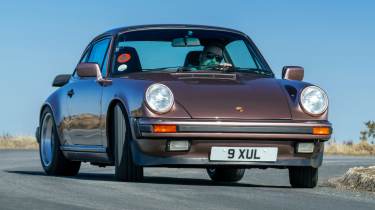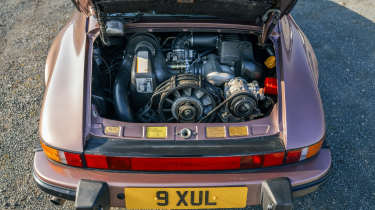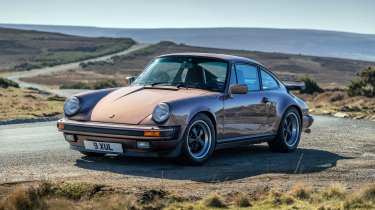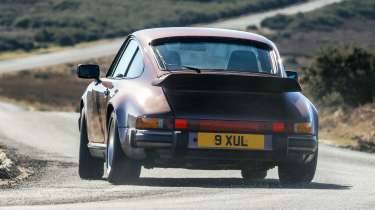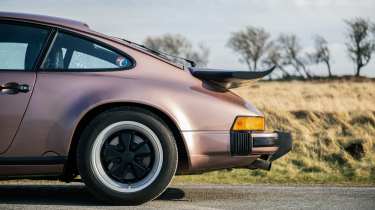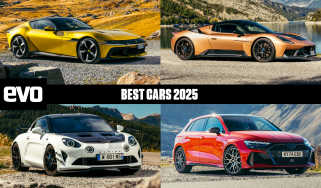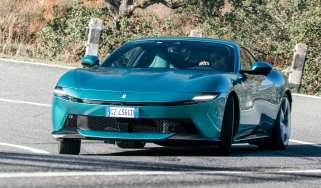Porsche 911 3.2 Carrera (1984 - 1989) review – flawed but furiously charming
The Porsche 911 had not become the perfected sports car we know and love today by the 1980s. But it was enormously charming and potent for its era
The Porsche 911 has been around for over six decades, but the 1960s were a long time ago. So while an early 2-litre is more of a ‘classic 911’ in the strictest sense, that expression may cause some people to picture something like a 1980s 3.2 Carrera. This is arguably the last truly classic 911.
It’s also the 911 that we featured on the roster for our evo eras 1980s test, alongside the Ferrari Testarossa, Audi Quattro, Peugeot 205 GTI, E30 BMW M3 and Mk1 Toyota MR2.
The 911 is so long-lived, it also served as our control car – the one that would feature in every generation of the eras test saga in some form or another. Is the 3.2 Carrera modern enough to be usable but still an evocative classic 911, or unappealing as a compromise between two eras? That is what we needed to find out.
History and specs
First launched in 1984, the 3.2 Carrera was at once the 911 as its fans already knew it and a taste of the great changes and innovations to come. The same basic physical architecture remained, as did air cooling, as it would until the demise of the 993 and the inception of the 996. It also retained much of the design sensibility of its immediate predecessors, not yet rounded of edge and smoothed of panel like the 964 that would succeed it.
More reviews
In-depth reviews
- Porsche 911 Carrera GTS T-Hybrid review – the first hybrid 911 is one of the best
- Used Porsche 911 (991, 2011 - 2018) review – should you buy the unloved 911?
- Porsche 911 Carrera (996, 1997-2005) review – an evo Car of the Year champion for under £20k
- Porsche 911 (992.2) 2025 review – the 911 for the digital age
Long term tests
Reviews
More significant than the extra displacement it packed over its predecessor, is that the 3.2 was the first 911 to feature electronically controlled fuel injection and ignition. Power and torque rose to 231bhp and 209lb ft as standard, a bump of around 15 per cent compared to the 3.0 SC. It was sent to the rear wheels via the proven but heavy-shifting five-speed G50 transmission.
> Porsche 911 (992.2) 2025 review – the 911 for the digital age
Improved gearbox and clutch mechanisms were introduced in 1987 to address the heavy feel for which the 3.2 was first criticised. Refinements in the electronic engine management systems gradually improved performance and efficiency, the latter being especially important in key low-emission markets of the 1980s like America and Germany.
The official 0-60mph time of 6.1sec was considered very conservative at the time by testers. Performance Car figured it a whole second quicker before hitting 156mph in testing on the Millbrook bowl – a performance described as ‘not a lot slower’ than the Lamborghini Countach.
Happily, what was a more potent car than Porsche claimed also came with larger, more heat-resistant brake discs, though the braking continued without servo assistance. Likewise the 3.2 would continue without power assistance for the steering, making it a notably physical experience, not to mention still capricious in terms of its handling characteristics in line with classic 911 folklore. That’s also in-part due to the suspension design it retained – the classic torsion bar.
While the 3.2 Carrera was available as a coupe, convertible or Targa, other options broadened (literally) the model’s visual scope. What’s affectionately known as the ‘Turbo look’, gave it the wide arches, bumpers, a rubber splitter and the distinctive Whale tail of the beloved 930. It also got the upgraded brakes and obviously much of the suspension hardware of the more powerful car to account for the added width. Earlier cars got the stiffer Turbo set-up while later ones kept the standard Carrera’s Boge dampers.
The Carrera Clubsport joined in 1985. It was lighter, more powerful and more focused. In a very real sense, it was the GT3 of the 1980s. The Carrera also spawned the Speedster, an evocation of the 356 Speedster of the 1950s.
When launched in 1984 the 3.2 Carrera cost from £22,537 but such was inflation in the 1980s, the 1987 car we tested would have cost from £32,849. That translates to £93,141 in today’s money – not a million miles off what a new basic 911 will set you back in 2025.
Driving the Porsche 911 3.2 Carrera – Peter Tomalin, evo eras: 1980s, issue 334
“The engine beats with that unmistakable air-cooled boxer pulse – deep, breathy. Being an ’88 model, this car benefits from the improved gearbox and clutch mechanism introduced in ’87, and this car has also had its engine taken out to 3.4 litres. But it’s still on the original torsion bar suspension, the steering’s unassisted and the brakes are unservo’d.
"So you expect a very physical experience, and boy does it deliver one. Seriously beefy steering, a heavy, slightly long-winded gearshift (and this was the improved version, don’t forget) and weighty pedal actions are seemingly at odds with the Carrera’s petite dimensions but well-matched to its meaty damping and the feeling of robustness that’s shot through the shell.
“The expanded engine delivers solid if unspectacular shove, doing its best work above 4000rpm where that wonderful flat-six wail seeps into the cabin – oh, and there’s a little gear-whine on top just to add another shot of character. Meanwhile the Carrera’s diminutive size is just perfect for these roads, the raised front wings making it almost Caterham-threadable.
"As with the Ferrari, there’s a little kickback through the steering, but it only adds to the sense of connection, the constant stream of feedback, while the damping is first-rate. This is classic 911, but not in a scary way – you can engage with its unique traits just as much as you want to. And you really do have to drive it – as Barker says, ‘The harder you go into a corner, the harder you have to steer it’ – and the further you drive, the more fun you have. It’s immensely satisfying.
“Dickie says that he’s increasingly drawn to 911s from this era, ‘I think because I need to engage more of the 911 techniques that I’ve learned over the years.’ But we’ve all fallen for the 3.2’s charms. ‘If this was eCoty 1988, the Porsche would win,’ winks Barker, the mischievous scamp.”
Porsche 911 3.2 Carrera values
Porsche 911s are famously long-legged so even cars with over 100,000 miles on their odometers are worth over £50,000 when in reasonable condition. Lower miles and clean condition will draw more cash. Coupes are unsurprisingly also worth more than their cabriolet counterparts.
> Porsche 911 Carrera (996, 1997-2005) review – an evo Car of the Year champion for under £20k
Such is the popularity of the 911 that everything you need to know about them as a prospective buyer is out there in abundance. Just speak to specialists. Anecdotally, these are cars that are sensitive to good maintenance, both in terms of their mechanicals, their bodywork and their interiors. Comprehensive history is essential. A recent engine rebuild at the hands of a reputable Porsche specialist, with receipts, would be desirable.
Porsche 911 3.2 Carrera specs
| Engine | Flat-six, 3164cc |
|---|---|
| Power | 231bhp @ 5900rpm |
| Torque | 209lb ft @ 4800rpm |
| Weight | 1159kg (203bhp/ton) |
| Tyres | Michelin Pilot Exalto |
| 0-60mph | 5.1sec |
| Top speed | 156mph |
| Price new | £32,849 (1987) |
| In today's money | £93,141 |
